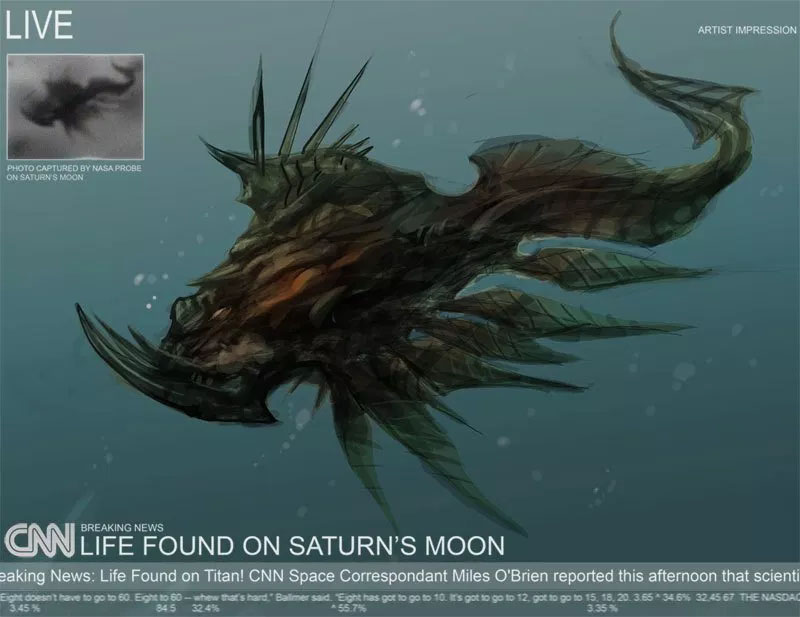looking for exotic aliens in our solar system
Titan, it’s the farthest place humans have ever landed a robotic probe and one of the most intriguing moons in the solar system, resembling a cryogenic version of our own planet when it was still young. Because it has an active cycle of organic compounds, a thick atmosphere, lakes of liquid natural gas and geologic activity, some astrobiologists are wondering if maybe, just maybe, some exotic chemistry could produce alien life on this icy world. What could these alien creatures look like? Have a peek at this concept for an aquatic creature lurking in Titan’s lakes from Malaysian sci-fi and fantasy artist Tham Hoi Mun as it would look on prime time TV news.

Now, it’s very unlikely that real aliens on Titan would be this complex because their basic chemistry would be profoundly different from our own. Basically, all life as we can conceptualize it, needs three things to exist and propagate: a source of energy, a solvent to aid vital chemical reactions, and a hereditary mechanism. Amino acids used by all living things on Earth are not only common in comets and asteroids, they even have a very similar bias in chiralities. Likewise, pyrimidine molecules, which are also abundant across space, turn into a a vital component for heredity when exposed to radiation, so it’s a safe bet that all the ingredients for genes and proteins are seeded all over Titan and plentiful quantities of methane could be metabolized to generate a rich medium for vast colonies of microorganisms that could build entire food chains.
But with an average temperature of -290°F on the surface, we have a big problem with a solvent necessary for vital chemical reactions. Water is out of the question since it would quickly freeze solid. However, where water can’t flow, developing aliens could turn to liquefied ethane. However, this would also mean that carbon might not necessarily be the best fit for building cells. Instead, life on Titan could use silicon and thrive in conditions that anything on Earth would find deadly. Silicon could make these creatures more rigid and might restrict the potential for evolution into bigger and more flexible forms. However, carbon-based life could still try to exist on the moon. What chemicals would spark the first microbial processes would depend on the content for Titan’s lakes being irradiated by cosmic rays and sunlight, but in the chilly medium, it doesn’t seem likely that there’s going be the kind of explosive activity we’ve seen on our own world for the last 600 million years or so…
See: Tokano, T. (2009). Limnological structure of Titan’s hydrocarbon lakes and its astrobiological implication Astrobiology, 9 (2), 147–164 DOI: 10.1089/ast.2007.0220
[ post suggestion by Colin Vestin ]





